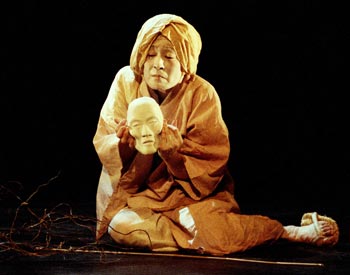| The curtain rises silently on a darkened stage. A faint spotlight reveals an old beggar woman bent over a thin walking stick in the rear of stage right. She fades from sight and reappears as if a cloud is passing through the moonlight. The crone moves towards centre stage at a pace slow and smooth as a moonwalk. Music moans like wind in a desolate place, broken by stark single notes of a koto.
The old woman collapses, slowly, Butoh style, painfully rises, abandons her fragile dead switch, staggers a few steps, bends with infinite care, and raises a green leafy branch over her head. This is our introductory view of Ono no Komachi (825-900), eminent poet, unparalleled in beauty and cruelty among the ladies of the Imperial court of Japan, who spent her old age in destitution wandering in dismal wastes, ugly, mad, and haunted by the ghostly victims of her past cruelties.
Lighting, costume, music and set design are each striking, and all work together to form a harmony that is compelling. The choreography by Yukio Waguri inspires total attention, as the single dancer’s movements through all six scenes unfold organically, like time-lapse photography of a leaf unfolding. There is no way to isolate Waguri’s dances from the dancer, Denise Fujiwara, as she manifests the Butoh-fu notation of poetic words that physicalize images of the Komachi story.
|
| That said, the performance concludes with two views that go past death. The first shows the Goddess of Compassion, Kannon, whose youthful facemask framed by long blond hair (albeit Fujiwara dances with her face and kimono on backwards) dispel all gloom. The final view, called "Children of Light", show Fujiwara inside a white tent like garment in which she performs the tender agitated movements of a chrysalis attempting to emerge from her cocoon.
Denise Fujiwara took her curtain call by making a series of kneeling bows that equaled with dignity and grace the tumultuous applause of the audience.
|


